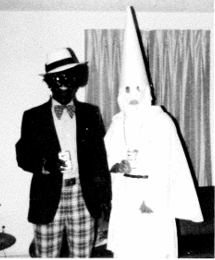Recently, in the comments section of an article about Virginia Governor Ralph Northam’s medical school yearbook photo, someone said that in 1984, (the year that the photo was taken), no one really understood that blackface was offensive.
Anyone with functioning empathy begs to differ.
It’s a particularly white standpoint to either claim ignorance of, or inability to understand the vulgarity and historical harm created by blackface.
But for argument’s sake, let’s take the first point: Assuming you don’t know anything about the history of blackface in the United States, think about the many instances where minority groups in this country have insisted over and over again that being caricatured and stereotyped is harmful. Native Americans have advocated for years that their culture and stereotypes of their dress should not be used as sports mascots and team names. Jews, Muslims, people of Asian descent, LGBTQ+ identifying folks… basically anyone who is not able-bodied, cis, white, male and Christian has said that stereotyping and lampooning of their characteristics is harmful.
One of the reasons white people seem to have a difficult time understanding that these stereotypes aren’t just “kidding around” and that they are actually harmful to members of a minority is that there’s no white corollary. Because whiteness in America has implicit and explicit power, lampooning whiteness doesn’t have the same implied violence or danger.
Put more simply: It isn’t dangerous to be white. White folks do not have a history of being brought to this country against their wills. White folks were not enslaved here. White folks killed, rounded up, and decimated groups that were here before them. So even without explicit knowledge of the practice of blackface, most folks should already be concerned about anything that presents a caricature of a minority.
Now, let’s take the historical part, since lots of people seem to have forgotten (or never learned) its context.
Blackface started in the US in the early- to mid-1800’s. Generally, it was a part of minstrel shows where white actors would darken their faces using burnt cork, or later, shoe polish, to represent “black” skin color. Just like the acting that accompanied blackface, it was meant to not “pass” or portray black Americans in a positive light. It was meant to exaggerate and make fun of what whites saw as stereotypically “black” features and culture.

So the first thing you need to know about blackface is that it was never intended to be kind. It was a symbol of the persistent and violent othering of black bodies and lives.
If you look at some of the historical images of blackface, it should be apparent that it was not done to simply and neutrally denote skin color, but rather to portray Black Americans as a negative stereotype physically and culturally.
In fact, one of the most popular minstrel show blackface characters of the time has a name you might have heard before: Jim Crow. While in today’s language, we most associate Jim Crow with sets of laws (Jim Crow Laws) that were enacted after the Civil War to maintain systematic oppression and segregation of black Americans. But it started as a minstrel show put on by a white theater player named Thomas D. Rice with a blackface character named Jim Crow
According to Wikipedia: “The ‘Jim Crow’ character[…] popularized a stereotype of African-Americans as ‘lazy, stupid, inherently less human, and unworthy of integration’.[2] Rice’s performances helped to popularize American minstrelsy, in which many performers imitated Rice’s use of blackface and stereotypical depiction, touring around the United States.[2] Those performers continued to spread the racist overtones and ideas manifested by the character to populations across the United States, contributing to white Americans developing a negative view of African-Americans in both their character and their work ethic.”
And lest anyone have read this entire article and dare come forth with arguments of “reverse racism” against whites, or question, “but what about whiteface?” you need only refer back to the two key points made above: 1. Whites have violent, systemic, economic and cultural power over blacks in this country, and 2. anyone with a functioning sense of empathy and decency knows it’s not ok to stereotype and insult other groups of people.
Just as today’s use of dehumanizing language towards groups of migrants at our borders should make us hear the echo of historical genocide, the appearance of blackface photos of anyone— but especially those who are charged with making laws and serving all people– should be disturbing and a deal-breaker. There are plenty of future leaders out there who have never had such lapses in judgment and character, and or who understand that we aren’t just products of our past. Our past can and must be overcome.

